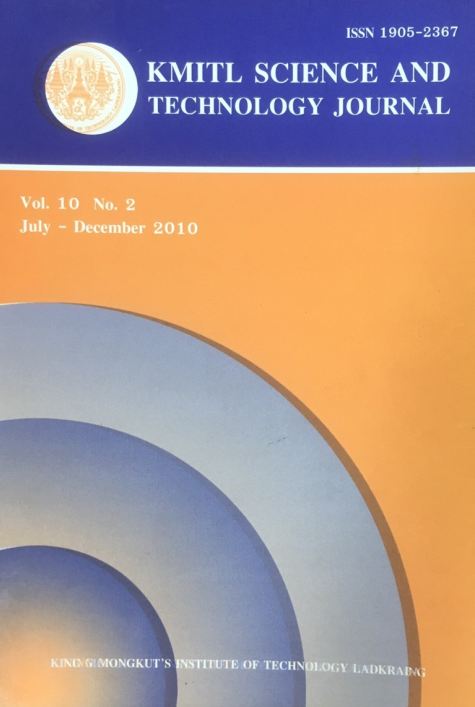Antifungal Activity of Ajowan Oil against Fusarium oxysporum
Main Article Content
Abstract
During the past decades, efforts in search of alternative fungicides have been focused on natural compounds from plant sources due to their less toxicity and more environmental compatible. In this study, essential oil extracted from mature seeds of ajowan (Trachyspermum ammi Lin.) was evaluated against three strains of Fusarium oxysporum, F. oxysporum f.sp. lycopersici, F.oxysporum f.sp. cubense and F. oxysporum f.sp. capsici the wilt pathogen of tomato, banana and chili respectively. The in vitro assay based on poison food method indicates that ajowan oil, in solution phase, possesses strong antifungal activity against the test fungi. The Minimum Inhibitory Concentration (MIC) and the Minimum Fungicidal Concentration (MFC) were 240 and 480 μgꞏmL-1, respectively. The antifungal activity of volatile headspace of the essential oil was evaluated under a modified atmosphere in inverted Petri-plates. Headspace vapor of ajowan oil has a strong activity with Minimum Inhibitory Quantity (MIQ) and the Minimum Fungicidal Quantity (MFQ) of 12.5 and 25.0 μl, respectively. Additionally, the effects of ajowan oil on the biomass production and sporulation of the test fungi indicate that it has significant retardation effect on the biomass production and sporulation of the fungi. Results suggested that ajowan oil has potential use as a biofungicide against the wilt pathogens.
Keywords: ajowan , Fusarium oxysporum, antifungal activity
E-mail: sirirat2@yahoo.com
Article Details
Copyright Transfer Statement
The copyright of this article is transferred to Current Applied Science and Technology journal with effect if and when the article is accepted for publication. The copyright transfer covers the exclusive right to reproduce and distribute the article, including reprints, translations, photographic reproductions, electronic form (offline, online) or any other reproductions of similar nature.
The author warrants that this contribution is original and that he/she has full power to make this grant. The author signs for and accepts responsibility for releasing this material on behalf of any and all co-authors.
Here is the link for download: Copyright transfer form.pdf
References
[2] Rodríguez-Gálvez, E. and Mendgen, K. 1995. The Infection process of Fusarium oxysporum in cotton root tips. Protoplasma 189(1-2), 61-72.
[3] Shi, J., Mueller, W. C. and Beckman, C.H. 1992. Vessel occlusion and secretory activities of vessel contact cells in resistant or susceptible cotton plants infected with Fusarium oxysporum f. sp. vasinfectum. Physiological and Molecular Plant Pathology, 40, 133-147.
[4] Schneider, S. M., Rosskopf, E. N., Leesch, J. G., Chellemi, D. O., Bull, C. T. and Mazzola,M. 2003. United States Department of Agriculture - Agricultural Research Service Research on alternatives to methyl bromide: Pre-plant and post-harvest. Pest Management Science, 59,814-826.
[5] Ocamb, C. M., Hamm, P. B. and Johnson, D. A. 2007. Benzimidazole resistance of Fusarium species recovered from potatoes with dry rot from storages located in the Columbia basin of oregon and Washington. American Journal of Potato Research, 84,169-177.
[6] Lee, S. O., Choi, G. J., Jang, K. S., Lim, H. K., Cho, K. Y. and Kim, J. C. 2007. Antifungal activity of five plant essential oils as fumigant against postharvest and soilborne plant pathogenic fungi, Plant Pathology Journal 23(2), 97-102.
[7] Soliman, K. M. and Badeaa, R. I. 2002. Effect of oil extracted from some medicinal plants on different mycotoxigenic fungi. Food Chemistry and Toxicology, 40, 1669-1675.
[8] Nagalakshmi, G., Shankaracharya., N. B. and Puranaik, J. 2000. Studies on chemical and technological aspects of ajowan (Trachyspermum ammi) syn (Carum copticum Hiren) seeds. Journal of Food Science and Technology, 37, 277- 281.
[9] Wu, H. S., Raza, W., Liu, D. Y., Wu, C. L., Mao, Z. S., Xu, Y. C. and Shen, Q. R. 2008. Allelophathic inpact of artificially applied coumarin on Fusarium oxysporum f.sp. niveum. World Journal of Microbiology and Biotechnology, 24, 1297-1304.
[10] Sahaf, B. Z. and Moharramipour, S. 2008. Fumigant toxicity of Carum copticum and Vitex pseudo-negundo essential oils against eggs, larvae and adults of Callosobruchus maculates. Journal of Pesticide Sciences, 81, 213-220.
[11] Siripornvisal, S. and Ngamchawee, K. 2010. Utilization of herbal essential oils as biofumigant against fungal decay of tomato during storage. Proceedings 16th Asian Agricultural Symposium, Bangkok, Thailand, 2010, pp. 655-658.
[12] Park, I. K., Kim, J., Lee, S. G. and Shin, S. C. 2007. Nematicidal activity of plant essential oils and components from Ajowan (Trachyspermum ammi), Allspice (Pimenta dioica) and Litsea (Litsea cubeba) essential oils against pine wood nematode (Bursaphelenchus Xylophilus). Journal of Nematology, 39(3), 275-279.
[13] Shojaaddini, M., Moharramipour, S. and Sahaf, B. Z. 2008. Fumigant toxicity of essential oil from Carum copticum against indian meal moth. Plodia Interpunctella Journal of Plant Protection Research, 48(4), 411-419.


